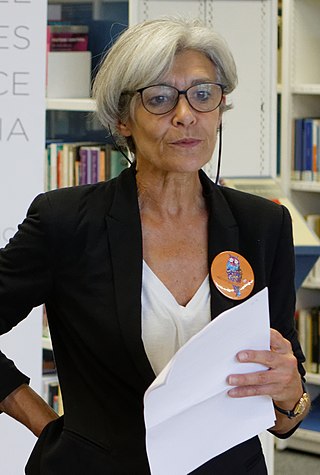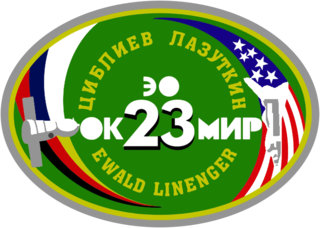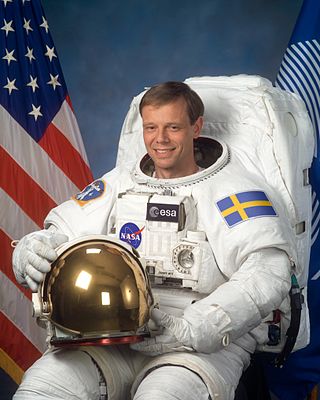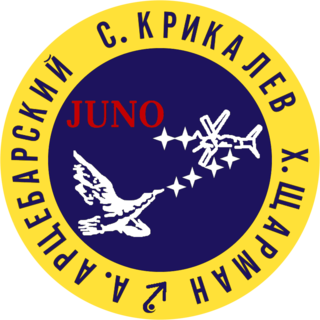
Ulf Dietrich Merbold is a German physicist and astronaut who flew to space three times, becoming the first West German citizen in space and the first non-American to fly on a NASA spacecraft. Merbold flew on two Space Shuttle missions and on a Russian mission to the space station Mir, spending a total of 49 days in space.

Claudie (André-Deshays) Haigneré is a French doctor, politician and former astronaut, the first woman astronaut of the French space agency CNES and the European space agency ESA which went to space.

Frank, Viscount De Winne is a Belgian Air Component officer and an ESA astronaut. He is Belgium's second person in space. He was the first ESA astronaut to command a space mission when he served as commander of ISS Expedition 21. ESA astronaut de Winne serves currently as Head of the European Astronaut Centre of the European Space Agency in Cologne/Germany (Köln).

Léopold "Leo" Eyharts is a French Brigadier General in the French Air Force, an engineer and ESA astronaut. He has flown to space two times as part of a Mir expedition and an International Space Station expedition.

Yuri Pavlovich Gidzenko is a Russian cosmonaut. He was a test cosmonaut of the Yuri Gagarin Cosmonaut Training Center (TsPK). Gidzenko has flown into space three times and has lived on board the Mir and the International Space Station. He has also conducted two career spacewalks. Although he retired on July 15, 2001, he continued his employment by a special contract until Soyuz TM-34 concluded. Since 2004 to May 2009, Gidzenko was the Director of the 3rd department within the TsPK. Since May 2009 he serves as the Deputy Chief of Cosmonaut Training Center TsPK.

Valery Grigoryevich Korzun is a former Russian cosmonaut. He has been in space twice totalling 381 days. He has also conducted four career spacewalks.

Michel Ange-Charles Tognini is a French test pilot, engineer, brigadier general in the French Air Force, and a former CNES and ESA astronaut who served from 1 January 2005 to 1 November 2011 as head of the European Astronaut Centre of the European Space Agency. A veteran of two space flights, Tognini has logged a total of 19 days in space. Tognini has 4000 flight hours on 80 types of aircraft. He is fluent in English and Russian.

Brigadier Roberto Vittori, OMRI is an Italian Air Force officer and an ESA astronaut. After graduating from the Italian Accademia Aeronautica in 1989, Vittori flew in the Italian Air Force. He then trained as a test pilot in the United States.

Soyuz TM-25 was a crewed Soyuz spaceflight, which launched on February 10, 1997. It transported Russian cosmonauts Vasily Tsibliyev, Aleksandr Lazutkin, and German cosmonaut Reinhold Ewald to Mir.

Pavel Vladimirovich Vinogradov is a former cosmonaut and commander of the International Space Station. He has flown into space three times, aboard Mir and the International Space Station, and was one of the top 10 astronauts in terms of total time in space after his third spaceflight. Vinogradov has also conducted seven spacewalks in his cosmonaut career, and holds the record for the oldest person to perform a spacewalk.

Thomas Arthur Reiter is a retired European astronaut and is a Brigadier General in the German Air Force currently working as ESA Interagency Coordinator and Advisor to the Director General at the European Space Agency (ESA). He was one of the top 25 astronauts in terms of total time in space. With his wife and two sons he lives near Oldenburg in Lower Saxony.

The German astronaut team was established in 1987. Before the establishment of the team, then-West German astronauts were selected for single missions, or as part of the European Space Agency's crewed spaceflight activities. East Germany had its first cosmonaut, Sigmund Jähn; Jähn was both West and East Germany's first citizen in space when he departed from Baikonur in the Soviet Union in August and returned to Earth in September 1978. West and East Germany reunified in 1990 and the astronaut team became representative of a single German nation.

Arne Christer Fuglesang is a Swedish physicist and an ESA astronaut. He was first launched aboard the STS-116 Space Shuttle mission on 10 December 2006, making him the first Swedish citizen in space.
The European Astronaut Corps is a unit of the European Space Agency (ESA) that selects, trains, and provides astronauts as crew members on U.S. and Russian space missions. The corps has 13 active members, able to serve on the International Space Station (ISS). The European Astronaut Corps is based at the European Astronaut Centre in Cologne, Germany. They can be assigned to various projects both in Europe or elsewhere in the world, at NASA Johnson Space Center or Star City.

Michael Reed Barratt is an American physician and a NASA astronaut. Specializing in aerospace medicine, he served as a flight surgeon for NASA before his selection as an astronaut and has played a role in developing NASA's space medicine programs for both the Shuttle-Mir Program and International Space Station. His first spaceflight was a long-duration mission to the International Space Station, as a flight engineer in the Expedition 19 and 20 crew. In March 2011, Barratt completed his second spaceflight as a crew member of STS-133. Barratt pilots the SpaceX Crew-8 mission that launched on 4 March 2024.

Project Juno was a privately funded campaign which selected Helen Sharman to be the first Briton in space.

Euromir was an international space programme in the 1990s. Between the Russian Federal Space Agency and the European Space Agency (ESA), it would bring European astronauts to the Mir space station.

Hervé Stevenin is a European aquanaut leading ESA Neutral Buoyancy Facility Operations and the EVA Training Unit at the European Astronaut Centre (EAC) in Cologne, Germany. He served as an aquanaut on the NASA Extreme Environment Mission Operations 19 crew.

Matthias Josef Maurer is a German ESA astronaut and Materials scientist, who was selected in 2015 to take part in space training.



















